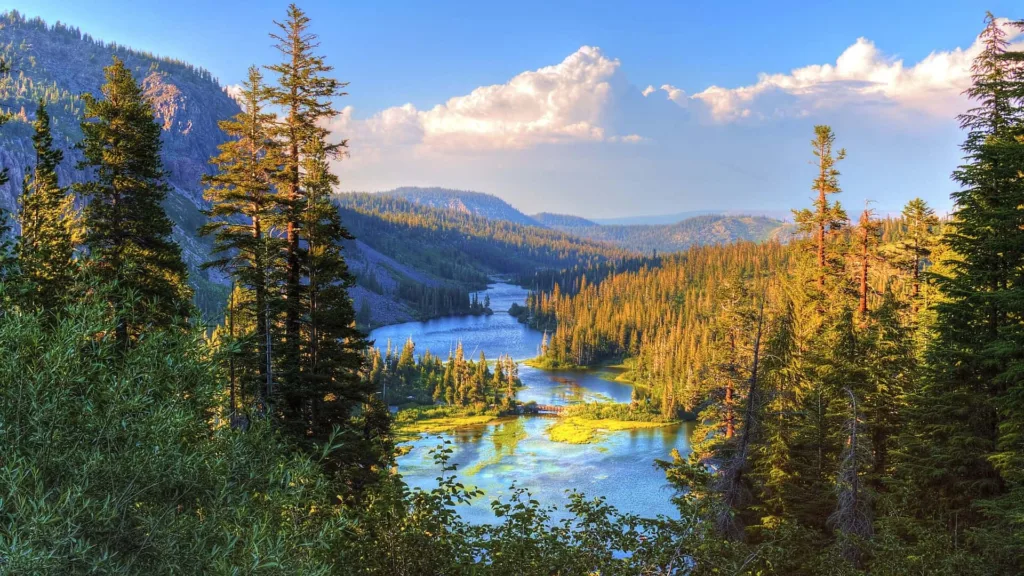In neighborhoods across America, the hum of lawnmowers and the scent of freshly cut grass are as familiar as weekend barbecues. But beneath this picturesque scene lies a complex environmental issue. The environmental impact of lawn care extends far beyond the boundaries of our yards, affecting water resources, air quality, and local ecosystems. Let’s dig deep into the roots of this issue and explore how our pursuit of the perfect lawn shapes the world around us.
Understanding the Environmental Impact of Traditional Lawn Care Practices

The Allure of the Perfect Lawn: A Brief History
The concept of a manicured lawn dates back centuries, but it’s in the last 70 years that it’s become a suburban staple. What started as a status symbol for the wealthy has evolved into a standard expectation for homeowners. This shift didn’t happen by accident.
From Status Symbol to Suburban Standard
In the post-World War II era, the idea of the perfect lawn took root alongside the growth of suburbs. Developers and lawn care companies promoted the image of a lush, green carpet as the ideal backdrop for the American Dream. This marketing push, combined with new chemical fertilizers and pesticides, made the perfect lawn seem achievable for everyone.
The Rise of Chemical-Intensive Lawn Care
The 1950s and 60s saw an explosion in chemical lawn treatments. Promises of weed-free, vibrant green grass led homeowners to embrace a cocktail of fertilizers, herbicides, and pesticides. Little thought was given to the long-term environmental impact of these lawn care practices.
Water Consumption: Quenching Your Lawn’s Thirst
One of the most significant environmental impacts of lawn care is water usage. The numbers are staggering.
How Much Water Does a Typical Lawn Really Need?
A typical lawn requires about 1 to 1.5 inches of water per week during the growing season. This translates to:
- 62 gallons per 100 square feet
- 6,200 gallons per 10,000 square feet
- Up to 25,000 gallons per year for an average-sized lawn
These figures don’t account for overwatering, which is common among homeowners striving for that perfect green.
The Strain on Local Water Resources
In many regions, particularly drought-prone areas, lawn irrigation puts immense pressure on local water supplies. During peak summer months, outdoor water use can account for 50-80% of residential water consumption.
Case Study: Las Vegas, Nevada
Las Vegas has implemented strict water conservation measures due to ongoing drought conditions:
| Year | Measure Implemented | Water Saved (Gallons/Year) |
|---|---|---|
| 2003 | Lawn watering restrictions | 9 billion |
| 2004 | “Cash for Grass” program | 10 billion |
| 2021 | Ban on “non-functional” turf | Estimated 10% of total water use |
These measures highlight the significant environmental impact of lawn care practices on water resources in arid regions.
Chemical Runoff: When Your Lawn Care Flows Downstream

The chemicals we apply to our lawns don’t stay put. Rain and irrigation wash these substances into our waterways, leading to far-reaching consequences.
Common Lawn Chemicals and Their Environmental Impacts
- Nitrogen and Phosphorus Fertilizers
- Cause algal blooms in water bodies
- Lead to fish kills and dead zones
- Pesticides
- Harm beneficial insects and pollinators
- Can be toxic to aquatic life
- Herbicides
- May persist in soil and water
- Can affect non-target plant species
Fertilizer Runoff and Water Pollution
Excess nutrients from fertilizers are a major source of water pollution. When these nutrients enter waterways, they fuel the growth of algae. As algae die and decompose, they consume oxygen, creating “dead zones” where aquatic life can’t survive.
Steps to Reduce Fertilizer Runoff:
- Use slow-release organic fertilizers
- Apply fertilizer in smaller, more frequent doses
- Never fertilize before heavy rain
- Create buffer zones near water bodies
- Test your soil to avoid over-fertilization
Pesticides: Friend or Foe to Local Ecosystems?
While pesticides can control unwanted insects, they often harm beneficial species as well. Bees, butterflies, and other pollinators are particularly vulnerable to these chemicals.
Biodiversity Loss: How Manicured Lawns Affect Local Ecosystems
The environmental impact of lawn care basics extends beyond chemical use and water consumption. Our obsession with pristine, weed-free lawns has transformed vast swaths of land into ecological deserts.
Monoculture Mayhem: The Ecological Cost of Grass-Only Landscapes
A typical lawn consists of only one or two grass species. This monoculture approach drastically reduces biodiversity and eliminates habitat for many species.
Native Plant Displacement and Its Ripple Effects
When we replace diverse native plants with grass, we disrupt entire food webs. Many insects rely on specific native plants for food and shelter. Birds, in turn, depend on these insects. The ripple effect continues up the food chain.
Benefits of Native Plants:
- Adapted to local climate and soil conditions
- Require less water and fertilizer
- Provide food and habitat for local wildlife
- Maintain soil health and prevent erosion
Impact on Pollinators and Beneficial Insects
Bees, butterflies, and other pollinators play a crucial role in our ecosystems and food production. The loss of diverse flowering plants in favor of grass lawns has contributed to alarming declines in pollinator populations.
Wildlife Displacement: When Lawns Replace Natural Habitats

As urban and suburban areas expand, lawns often replace natural habitats. This transformation has far-reaching consequences for local wildlife.
Birds, Small Mammals, and Reptiles: The Casualties of Perfect Lawns
Many species struggle to adapt to the homogeneous landscape of suburban lawns:
- Ground-nesting birds lose nesting sites
- Small mammals have fewer places to hide from predators
- Reptiles lose basking spots and hunting grounds
Fragmentation of Urban and Suburban Ecosystems
Lawns create barriers between natural areas, making it difficult for wildlife to move freely. This fragmentation can lead to genetic isolation and local extinctions of some species.
Sustainable Alternatives: Reducing the Environmental Impact of Lawn Care
The good news is that we can significantly reduce the environmental impact of lawn care through sustainable practices and alternative landscaping approaches.
Eco-Friendly Lawn Care Practices
Small changes in how we care for our lawns can make a big difference:
- Organic Fertilizers and Natural Pest Control Methods
- Compost and organic fertilizers improve soil health
- Integrated Pest Management (IPM) reduces chemical use
- Water-Wise Irrigation Techniques
- Install smart irrigation systems
- Water deeply but less frequently to encourage deep root growth
- Electric and Manual Lawn Equipment Options
- Electric mowers produce zero emissions during use
- Manual tools like rakes and push mowers offer exercise benefits
Beyond Grass: Alternative Landscaping Ideas
Rethinking the traditional lawn can lead to beautiful, low-maintenance landscapes that support local ecosystems.
Native Plant Gardens: Beauty with a Purpose
Creating a native plant garden can transform your yard into a haven for local wildlife. Here’s how to get started:
- Research plants native to your area
- Choose a variety of plants that bloom at different times
- Group plants with similar water and sunlight needs
- Start small and expand over time
- Be patient – native gardens may take a few years to fully establish
Xeriscaping: Thriving in Dry Climates
Xeriscaping is a landscaping approach that reduces or eliminates the need for irrigation. It’s particularly well-suited to arid regions but can be adapted to any lawn care climate.
Key Principles of Xeriscaping:
- Use drought-tolerant plants
- Improve soil with organic matter
- Mulch to retain moisture
- Minimize turf areas
- Use efficient irrigation methods
Food Forests and Edible Landscapes
Combining ornamental and edible plants can create a productive, beautiful landscape that also supports local wildlife.
Elements of an Edible Landscape:
- Fruit and nut trees
- Berry bushes
- Herb gardens
- Vegetable plots
- Edible flowers
The Future of Lawn Care: Balancing Aesthetics and Environmental Responsibility

As we become more aware of the environmental impact of lawn care, new technologies and approaches are emerging to help us maintain beautiful outdoor spaces without compromising our ecosystems.
Technological Innovations in Sustainable Lawn Maintenance
- Smart Irrigation Systems and Weather-Based Controllers
- Adjust watering based on real-time weather data
- Can reduce water use by up to 30%
- Robotic Mowers and Their Environmental Impact
- Run on electricity, reducing emissions
- Cut grass more frequently, returning small clippings to the soil as natural fertilizer
- Synthetic Turf: A Viable Alternative or Another Environmental Concern?
- Eliminates need for water, fertilizers, and mowing
- Concerns about microplastic pollution and heat island effects
Climate Change and the Evolution of Lawn Care
As our climate changes, so too must our approach to landscaping. Adaptive strategies will be crucial in maintaining outdoor spaces that can withstand extreme weather events and changing precipitation patterns.
Adapting Lawn Care Practices to Changing Weather Patterns:
- Choose grass varieties suited to your changing local climate
- Implement rainwater harvesting systems
- Create rain gardens to manage stormwater runoff
Economic Considerations: The True Cost of Lawn Care
While sustainable lawn care practices may seem more expensive upfront, they often lead to long-term savings. Consider the following:
| Traditional Lawn Care | Sustainable Lawn Care |
|---|---|
| High water bills | Reduced water usage |
| Regular chemical treatments | Minimal to no chemical inputs |
| Frequent mowing (fuel/electricity costs) | Less frequent mowing |
| Potential health costs from chemical exposure | Healthier environment for family and pets |
Conclusion: Reimagining Our Relationship with Lawns
The environmental impact of lawn care is significant, but not irreversible. By rethinking our approach to outdoor spaces, we can create beautiful, functional landscapes that support local ecosystems and reduce our environmental footprint.
Key Takeaways for Environmentally Conscious Lawn Care
- Reduce chemical use through organic methods and IPM
- Conserve water with efficient irrigation and drought-tolerant plants
- Embrace biodiversity by incorporating native plants
- Consider alternatives to traditional lawns, like xeriscaping or edible landscapes
- Stay informed about new technologies and practices in sustainable lawn care
Small Changes, Big Impact: Your Role in Sustainable Landscaping
Every yard, no matter how small, can make a difference. By implementing even a few of the strategies discussed in this article, you can contribute to a healthier, more sustainable environment. Remember, the goal isn’t perfection, but progress. As we collectively shift our approach to lawn care, we can create a patchwork of healthy, diverse ecosystems right in our own neighborhoods.
The lawn of the future isn’t just green – it’s vibrant, diverse, and alive with the buzz of pollinators and the songs of birds. It’s a lawn that not only looks good but does good, supporting local wildlife and contributing to the health of our planet. By understanding and mitigating the environmental impact of lawn care, we can turn our yards into powerful tools for positive change.


